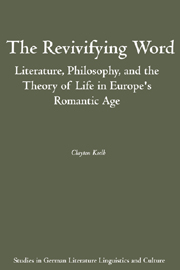Book contents
- Frontmatter
- Contents
- Preface
- Note on Abbreviations and Translations
- Part I Letter and Spirit
- Introduction: “The Dead Man's Life”: Romantic Reading and Revivification
- 1 “The Sound Which Echoes in Our Soul”: The Romantic Aesthetics of Matter and Spirit
- 2 “Spirit Thinks Only Through the Body”: Materialist Spiritualism in Romantic Europe
- Part II The Dead and Living Past
- Part III The Incarnate Word
- Conclusion
- Works Cited
- Index
1 - “The Sound Which Echoes in Our Soul”: The Romantic Aesthetics of Matter and Spirit
from Part I - Letter and Spirit
Published online by Cambridge University Press: 05 February 2013
- Frontmatter
- Contents
- Preface
- Note on Abbreviations and Translations
- Part I Letter and Spirit
- Introduction: “The Dead Man's Life”: Romantic Reading and Revivification
- 1 “The Sound Which Echoes in Our Soul”: The Romantic Aesthetics of Matter and Spirit
- 2 “Spirit Thinks Only Through the Body”: Materialist Spiritualism in Romantic Europe
- Part II The Dead and Living Past
- Part III The Incarnate Word
- Conclusion
- Works Cited
- Index
Summary
THE MIRACLE OF THE REVIVIFYING WORD results from the paradoxical coexistence of death and life in a single phenomenon, and the principal theater for the performance of such magic is the scene of reading. The vocabulary of Paul in 2 Corinthians provides an essential concept for Romantic aesthetics: the dead letter and the living spirit exist together in the poetic text. Hamann was perhaps the first of the German aestheticians to put Paul's vocabulary to work in the service of a theory of art, but he was by no means the last or even the most prominent. The same idea — and the same vocabulary — recurs in Kant's Critique of Judgment (Kritik der Urteilskraft, 1790). While it would be difficult or impossible to reconcile Hamann's antirationalist mysticism with Kant's critical philosophy on most issues, there is a remarkable agreement in this one area. For like Hamann, Kant understands the central question of aesthetics to be “How are we to raise the defunct language of Nature from the dead?” When Hamann claims that “Nature and Scripture are the materials of the beautiful, creating, imitating spirit” (147; translation modified for clarity), he is very close to the path that his friend and fellow Königsberger Kant would follow a few years later. Kant, of course, does not share Hamann's views on Scripture, but with that one revision Hamann's assertion could stand as an epigraph to the Third Critique: Nature is the material of the creating spirit.
- Type
- Chapter
- Information
- The Revivifying WordLiterature, Philosophy, and the Theory of Life in Europe's Romantic Age, pp. 14 - 29Publisher: Boydell & BrewerPrint publication year: 2008



